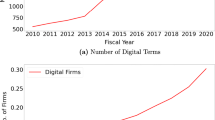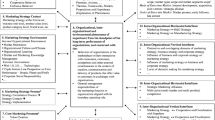Abstract
Using a novel data set on new product introductions in U.S. manufacturing, the paper studies the relationship between new product introductions and the intensity of market competition as it is measured by industry-specific price-cost margins. New product introductions intensify market competition and depress price-cost margins. These results draw significant empirical support from a sample of five U.S. manufacturing industries. A 10 percent increase in the number of new product introductions causes price-cost margins to drop by approximately 0.5 percent. Although price-cost margins appear procyclical with respect to fluctuations in industry sales, new products make price-cost margins less procyclical and therefore, the intensity of market competition more procyclical.
Similar content being viewed by others
References
Axarloglou, K. “The Cyclicality of New Product Introductions,”Journal of Business, 76, 1, 2003, pp. 29–48.
Bils, M. “Pricing in a Customer Market,”Quarterly Journal of Economics, 104, 4, 1989, pp. 699–718.
Campa, J.; Goldberg, L. “Employmentversus Wage Adjustment in the U.S. Dollar,” in R. Feenstra, ed.,Trade and Wages, University of Chicago Press, 1998.
Chevalier, J.; Scharfstein, D. “Capital-Market Imperfections and Counter-Cyclical Markups: Theory and Evidence,”American Economic Review, 86, 4, 1996, pp. 703–25.
Dixit, A. K.; Stiglitz, J. E. “Monopolistic Competition and the Optimum Product Diversity,”American Economic Review, 67, 2, 1977, pp. 297–308.
Domovitz, I.; Hubbard, R. G.; Petersen, B. C. “Business Cycles and the Relationship Between Concentration and Price-Cost Margins,”Rand Journal of Economics, 17, 1, 1986, pp. 1–17.
—— “Market Structure and the Cyclical Fluctuations in U.S. Manufacturing,”Review of Economics and Statistics, 70, 1, 1988, pp. 55–66.
Field, K. M.; Pagoulatos, E. “The Cyclical Behavior of Price Elasticity of Demand,”Southern Economic Journal, 64, 1, 1997, pp. 118–29.
Krippendorff, K.Content Analysis: An Introduction to its Methodology, Sage Publications, Beverly Hills, London, 1980.
Perloff, J.; Salop, S. “Equilibrium with Product Differentiation,”Review of Economic Studies, 52, 1, 1985, pp. 107–20.
Rotemberg, J.; Saloner, G. “A Supergame Theoretic Model of Price Wars During Booms,”American Economic Review, 76, 3, 1986, pp. 390–407.
Rotemberg, J.; Woodford, M. “Markups and the Business Cycle,”NBER Macroeconomic Annual, 1991.
Salinger, M. “The Concentration-Margins Relation Reconsidered,” Brookings Papers on Economic Activity, 1990, pp. 287–335.
Salop, S. C. “Monopolistic Competition with Outside Goods,”Bell Journal of Economics, 10, 1, 1979, pp. 141–156.
Warner, E.; Barsky, R. “The Timing and Magnitude of Retail Store Markdowns: Evidence from Weekends and Holidays,”Quarterly Journal of Economics, 110, 2, 1995, pp. 321–52.
Author information
Authors and Affiliations
Additional information
The author would like to thank the Board of Research at Babson College for their generous financial support. The author would also like to thank Jane Cloran for assisting with some of the data. All of the remaining errors are the responsibility of the author.
Rights and permissions
About this article
Cite this article
Axarloglou, K. New products and market competition. International Advances in Economic Research 10, 226–234 (2004). https://doi.org/10.1007/BF02296217
Issue Date:
DOI: https://doi.org/10.1007/BF02296217




